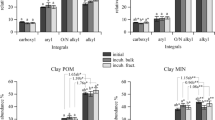Abstract
Organic-mineral soil particles are formed and altered as a result of pedogenic processes and anthropogenic impacts on soils. They can be isolated from bulk soil samples by physical disaggregation followed by particle size and/or density fractionation. This review summarizes methodological advances and the characteristic features of the chemical composition of organic matter in these different fractions. It is demonstrated how soil texture and soil genesis determine the contents of organic C (Corg) in size-separates and their distribution in typical profiles of four important major soil groups. Data from numerous field studies were compiled to show that the proportions of Corg bound in clay fractions increased under soil uses which reduce the soil organic matter (SOM) content. Coarser and lighter particles are relatively enriched in native or manured soils. Contents of humic substances, lignin oxidation products, carbohydrates, lipids, and forms of organic N determined by wet-chemical methods indicate that the chemical composition results from specific functions of the organic-mineral particles in the turnover of SOM. This is also reflected by 13C-nuclear magnetic resonance and analytical pyrolysis, the applications of which to the study of organic-mineral particles are summarized and compared for the first time. The summarized chemical characteristics of organic-mineral particles have direct effects on other properties such as soil aggregation and the resulting physical behaviour of soil. Moreover, the adsorption and distribution of plant nutrients, as well as the binding capacity for a wide range of pollutants, clearly show that the organic matter is a key factor for the physicochemical reactions at organic-mineral surfaces. Along with evidence for the different mineralizability of Corg and organic N, and enzymatic properties, the accumulated knowledge of their composition, structure and properties provides a basis from which to develop molecular models of organic-mineral particles. Molecular modelling and visualization of humic colloids, SOM and its complexes (organic-mineral particles) with biological substances, metals and xenobiotics are discussed. These model complexes offer a basis for the conceptual development of SOM macromolecules, mineral soil particles and the computer-assisted design of organic-mineral particles. Molecular-mechanics calculations and geometrical optimization are employed to obtain energy minimized, stable conformations which allow the determination of atomic distances, bonds, angles, torsions, stretches, etc., at nanochemical level. As a result, exact descriptions of three-dimensional structures can be proposed. The total (potential) energy of the organic matter complexes and macromolecules can be determined simultaneously, and energy derivatives for bond-, angle-, dihedral-, van der Waals′, stretch-bend, and electrostatic energies calculated. Moreover, quantitative structure-activity relationship software is employed to calculate relevant molecular properties such as surface, volume, atomic charges, polarizability, refractivity, etc. It is this combination of atomic/molecular structural data and energy derivatives that opens up new insights into binding sites and transport forms between biological and/or xenobiotic substances and SOM. The resulting potential, and limits, for modelling of organic (humic) macromolecules, organic-mineral particles and mineral surfaces are delineated.
Similar content being viewed by others
Author information
Authors and Affiliations
Additional information
Received: 19 July 1999
Rights and permissions
About this article
Cite this article
Schulten, HR., Leinweber, P. New insights into organic-mineral particles: composition, properties and models of molecular structure. Biol Fertil Soils 30, 399–432 (2000). https://doi.org/10.1007/s003740050020
Issue Date:
DOI: https://doi.org/10.1007/s003740050020




